List of Presidents of the Republic of China


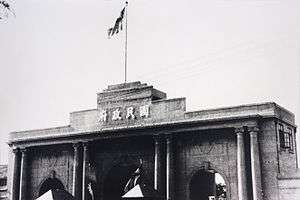
This is a list of the Presidents of the Republic of China (1912–present). The Republic of China's President is called 總統 (zǒngtǒng), and from 1912 to 1928, 大總統 (dàzǒngtǒng). The Republic of China before 1949 controlled mainland China as well as offshore islands. The Republic of China since 1949 has only controlled Taiwan and nearby islands. This current Republic of China is usually known as Taiwan.
Timeline of Presidents

List of Presidents before the 1947 constitution
Presidents of the Provisional Government
- Period: 1 January 1912 – 10 October 1913
Tongmenghui Beiyang clique, etc.
| № | Portrait | Name (Birth–Death) |
Term of Office | Political Party | Vice President | |
|---|---|---|---|---|---|---|
| 1 |  |
Sun Yat-sen 孫文 Sūn Wén (1866–1925) |
1 January 1912 | 10 March 1912 | Tongmenghui | Li Yuanhong |
| 1911 (94.11%) | ||||||
| The first President of the Provisional Government | ||||||
| 2 | 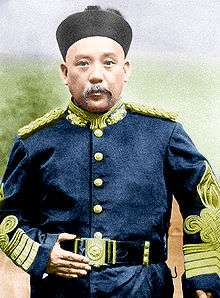 |
Yuan Shikai 袁世凱 Yuán Shìkǎi (1859–1916) |
10 March 1912 | 10 October 1913 | Beiyang clique | Li Yuanhong |
| 1912 (100%) | ||||||
| The second President of the Provisional Government | ||||||
Presidents of the Beiyang Government
- Period: 10 October 1913 – 2 June 1928
Non-partisan Beiyang clique, etc. Progressive
| № | Portrait | Name (Birth–Death) |
Term of Office | Political Party | Vice President | |
|---|---|---|---|---|---|---|
| 1 | 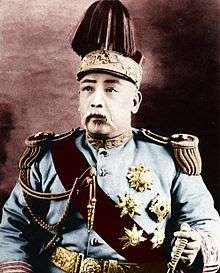 |
Yuan Shikai 袁世凱 Yuán Shìkǎi (1859–1916) |
10 October 1913 | 6 June 1916[1] | Beiyang clique | Li Yuanhong |
| 1913 (71.12%) | ||||||
| Died in office. | ||||||
| 2 |  |
Li Yuanhong 黎元洪 Lí Yuánhóng (1864–1928) |
7 June 1916 | 17 July 1917[2] | Progressive Party | Feng Guozhang |
| As Vice-President under Yuan Shikai, Li became the president after Yuan's death. | ||||||
| 3 |  |
Feng Guozhang 馮國璋 Féng Guózhāng (1859–1919) |
17 July 1917 | 10 October 1918 | Zhili clique | vacant |
| Due to Manchu Restoration, Li Yuanhong fled the presidential palace and appointed Vice President Feng Guozhang as Acting President. | ||||||
| 4 |  |
Xu Shichang 徐世昌 Xú Shìchāng (1855–1939) |
10 October 1918 | 2 June 1922 | Anhui clique | vacant |
| 1918 (98.15%) | ||||||
| — |  |
Zhou Ziqi 周自齊 Zhōu Zìqí (1871–1923) |
2 June 1922 | 11 June 1922 | Communications Clique | vacant |
| 5 |  |
Li Yuanhong 黎元洪 Lí Yuánhóng (1864–1928) |
11 June 1922 | 13 June 1923 | Research Clique | vacant |
| — |  |
Gao Lingwei 高凌霨 Gāo Língwèi (1868–1939) |
14 June 1923 | 10 October 1923 | Non-partisan | vacant |
| 6 | 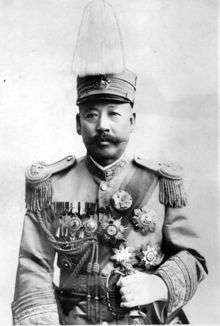 |
Cao Kun 曹錕 Cáo Kūn (1862–1938) |
10 October 1923 | 2 November 1924 | Zhili clique | vacant |
| 1923 (81.36%) | ||||||
| — |  |
Huang Fu 黃郛 Huáng Fú (1883–1936) |
2 November 1924 | 24 November 1924 | Non-partisan | vacant |
| 7 |  |
Duan Qirui 段祺瑞 Duàn Qíruì (1865–1936) |
24 November 1924 | 20 April 1926 | Anhui clique | vacant |
| Duan was the Provisional Chief Executive instead of President. | ||||||
| — |  |
Hu Weide 胡惟德 Hú Wéidé (1863–1933) |
20 April 1926 | 13 May 1926 | Non-partisan | vacant |
| — |  |
Yan Huiqing (W.W. Yan) 顏惠慶 Yán Huìqìng (1877–1950) |
13 May 1926 | 22 June 1926 | Non-partisan | vacant |
| — |  |
Du Xigui 杜錫珪 Dù Xīguī (1875–1933) |
22 June 1926 | 1 October 1926 | Zhili clique | vacant |
| — | 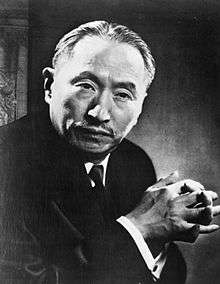 |
Koo Vi-kyuin (Wellington Koo) 顧維鈞 Gù Wéijūn (1888–1985) |
1 October 1926 | 17 June 1927 | Non-partisan | vacant |
| 8 | 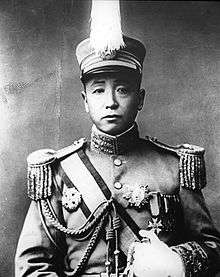 |
Zhang Zuolin 張作霖 Zhāng Zuòlín (1875–1928) |
18 June 1927 | 2 June 1928 | Fengtian clique | vacant |
| Zhang was the Generalissimo of the Beiyang Military Government instead of President. | ||||||
Chairmen of the Nationalist Government
- Period: 7 February 1928 – 20 May 1948
Kuomintang (Nationalist)
The head of state of the Nationalist Government (國民政府) in this period (political tutelage, 訓政時期).
| № | Portrait | Name (Birth–Death) |
Term of Office | Political Party | Vice President | |
|---|---|---|---|---|---|---|
| 1 |  |
Tan Yankai 譚延闓 Tán Yánkǎi (1880–1930) |
7 February 1928 | 10 October 1928 | Kuomintang | vacant |
| 2 |  |
Chiang Kai-shek 蔣中正 Jiǎng Zhōngzhèng (1887–1975) |
10 October 1928 | 15 December 1931 | Kuomintang | vacant |
| 3 |  |
Lin Sen 林森 Lín Sēn (1868–1943) |
15 December 1931 | 1 August 1943 | Kuomintang | vacant |
| Died in office. | ||||||
| 4 |  |
Chiang Kai-shek 蔣中正 Jiǎng Zhōngzhèng (1887–1975) |
1 August 1943 | 20 May 1948 | Kuomintang | vacant |
Lists of Presidents after the 1947 Constitution
Presidents elected by the National Assembly
- Period: 20 May 1948 – 20 May 1996
Kuomintang (Nationalist)
In the fall of 1949 the ROC government retreated to Taiwan and surrounding islands as a result of the takeover of China by the People's Republic of China. The capital was moved to Taipei. Martial law was ended in Taiwan in the 1980s and direct elections were introduced in 1996.
| № | Portrait | Name (Birth–Death) |
Term of Office | Term | Elections | Political Party | Vice President | |
|---|---|---|---|---|---|---|---|---|
| 1 |  |
Chiang Kai-shek 蔣中正 Jiǎng Zhōngzhèng (1887–1975) |
20 May 1948 | 21 January 1949 | 1 | 1948 (90.03%) | Kuomintang | Li Zongren |
| Declared incapacity to discharge duties and powers as President following a succession of defeats by the Communists in the Chinese Civil War. | ||||||||
| — | 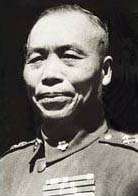 |
Li Zongren 李宗仁 Lǐ Zōngrén (1890–1969) |
21 January 1949 | 1 March 1950 | 1 | — | Kuomintang | Vacant |
| Acting President on Chiang Kai-shek's declaration of incapacity. Had an antagonistic relationship with Chiang. After the fall of Guangdong, Li flew to New York. | ||||||||
| — |  |
Yan Xishan 閻錫山 Yán xíshān (1883–1960) |
20 November 1949 | 1 March 1950 | 1 | — | Kuomintang | Vacant |
| After Li fled to New York, Premier Yan became acting president according to Article 49 of Constitution. 1 March 1950, Chiang re-assumed the presidency, but Li Zongren denounced Chiang's re-assumption as unconstitutional. | ||||||||
| 1 |  |
Chiang Kai-shek 蔣中正 Jiǎng Zhōngzhèng (1887–1975) |
1 March 1950 | 20 May 1954 | 1 | — | Kuomintang | Li Zongren (1950–1954[3]) Vacant (1954) |
| 20 May 1954 | 20 May 1960 | 2 | 1954 (96.91%) | Chen Cheng | ||||
| 20 May 1960 | 20 May 1966 | 3 | 1960 (93.97%) | Chen Cheng (1960–1965[4]) Vacant (1965–1966) | ||||
| 20 May 1966 | 20 May 1972 | 4 | 1966 (98.60%) | Yen Chia-kan | ||||
| 20 May 1972 | 5 April 1975 | 5 | 1972 (99.39%) | Yen Chia-kan | ||||
| Defeated on the mainland; moved the government to Taipei. Resumed office on 1 March 1950. Imposed martial law under the Temporary Provisions Effective During the Period of Communist Rebellion; period of white terror. Implemented sweeping land reforms. Died in office. | ||||||||
| 2 | 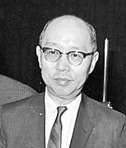 |
Yen Chia-kan (C.K. Yen) 嚴家淦 Yán Jiāgàn (1905–1993) |
6 April 1975 | 20 May 1978 | 5 | — | Kuomintang | Vacant |
| Premier (1963–1972). As Vice-President under Chiang Kai-shek, Yan succeeded to the Presidency on Chiang's death and completed Chiang's term. | ||||||||
| 3 |  |
Chiang Ching-kuo 蔣經國 Jiǎng Jīngguó (1910–1988) |
20 May 1978 | 20 May 1984 | 6 | 1978 (98.34%) | Kuomintang | Hsieh Tung-min |
| 20 May 1984 | 13 January 1988 | 7 | 1984 (95.11%) | Lee Teng-hui | ||||
| Son of Chiang Kai-shek. Oversaw completion of the Ten Major Construction Projects and economic modernization of Taiwan (Taiwan miracle). Presided at time of growing democratic movements (Kaohsiung Incident); ended martial law. Died in office. | ||||||||
| 4 | 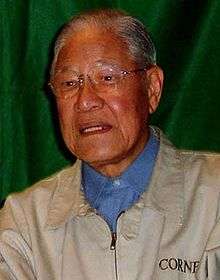 |
Lee Teng-hui 李登輝 Lǐ Dēnghuī (1923–) |
13 January 1988 | 20 May 1990 | 7 | — | Kuomintang | Vacant |
| 20 May 1990 | 20 May 1996 | 8 | 1990 (85.24%) | Li Yuan-zu | ||||
| As Vice President (1984–1988) under Chiang Ching-kuo, Lee succeeded to the Presidency on Chiang's death and completed Chiang's term. Oversaw democratic reforms. Served as Mayor of Taipei (1978–1981), Governor of Taiwan Province (1981–1984), Chairman of Kuomintang (1988–2000). First native Taiwanese President. | ||||||||
Presidents after the introduction of Direct Election
- Period: 20 May 1996 – present
Kuomintang (Nationalist) Democratic Progressive
| № | Portrait | Name (Birth–Death) |
Term of Office | Term | Electoral mandates | Political Party | Vice President | |
|---|---|---|---|---|---|---|---|---|
| 4 |  |
Lee Teng-hui 李登輝 Lǐ Dēnghuī (1923–) |
20 May 1996 | 20 May 2000 | 9 | 1996 5,813,699 (54.0%) | Kuomintang | Lien Chan |
| First president elected by direct election. Term saw the manifestation of "black gold" politics within the KMT. Cross-strait tensions over promotion of "special state-to-state relations" with mainland China. | ||||||||
| 5 |  |
Chen Shui-bian 陳水扁 Chén Shuǐbiǎn (1950–) |
20 May 2000 | 20 May 2004 | 10 | 2000 4,977,737 (39.3%) | Democratic Progressive Party | Annette Lu |
| 20 May 2004 | 20 May 2008 | 11 | 2004 6,446,900 (50.11%) | |||||
| First Pan-Green and pro-Taiwan independence President. Promoted Taiwanization policies; increased cross strait tensions due to pro-independence stance. Abruptly halted construction of the Number Four Nuclear Power Facility, leading to antagonistic relations with the opposition. Served as Member of the Legislative Yuan for Taipei 1st District (1990–1994), Mayor of Taipei (1994–1998) and Chairman of DPP (2002–2004, 2007–2008). Sentenced to imprisonment for corruption. | ||||||||
| 6 |  |
Ma Ying-jeou 馬英九 Mǎ Yīngjiǔ (1950–) |
20 May 2008 | 20 May 2012 | 12 | 2008 7,658,724 (58.45%) | Kuomintang | Vincent Siew |
| 20 May 2012 | 20 May 2016 | 13 | 2012 6,891,139 (51.60%) | Wu Den-yih | ||||
| Led efforts to ease cross strait tensions; oversaw the opening of the Three Links to mainland China and the signing of the Economic Cooperation Framework Agreement. First president to meet with the paramount leader of the People's Republic of China since the end of the Chinese Civil War in 1949. Attempt to pass the Cross-Strait Service Trade Agreement led to mass student protests and an occupation of the legislature. Served as Minister of Justice (1993–1996), Mayor of Taipei (1998–2006), Chairman of Kuomintang (2005–2007, 2009–2014). First administration with a DPP majority (2016) in the Legislative Yuan. | ||||||||
| 7 |  |
Tsai Ing-wen 蔡英文 Cài Yīngwén (1956–) |
20 May 2016 | Incumbent | 14 | 2016 6,894,744 (56.1%) | Democratic Progressive Party | Chen Chien-jen |
| Vice Premier (2006–2007), Chairman of DPP (2008–2012, 2014–). First female President, first President of Aboriginal descent (1/4 Paiwan), first administration with DPP controlling both executive and legislative branches, first elected president without having previously served as Taipei mayor. | ||||||||
See also
- List of Vice Presidents of the Republic of China
- List of premiers of the Republic of China
- List of vice premiers of the Republic of China
- List of rulers of Taiwan
References
- ↑ Restored the monarchy from 12 December 1915 to 22 March 1916.
- ↑ Zhang Xun restored Qing Empire from 1 July to 12 July in 1917.
- ↑ Impeached, recalled in 1954.
- ↑ Chen Cheng, Died on 5 March 1965.
| Wikimedia Commons has media related to Presidents of the Republic of China. |